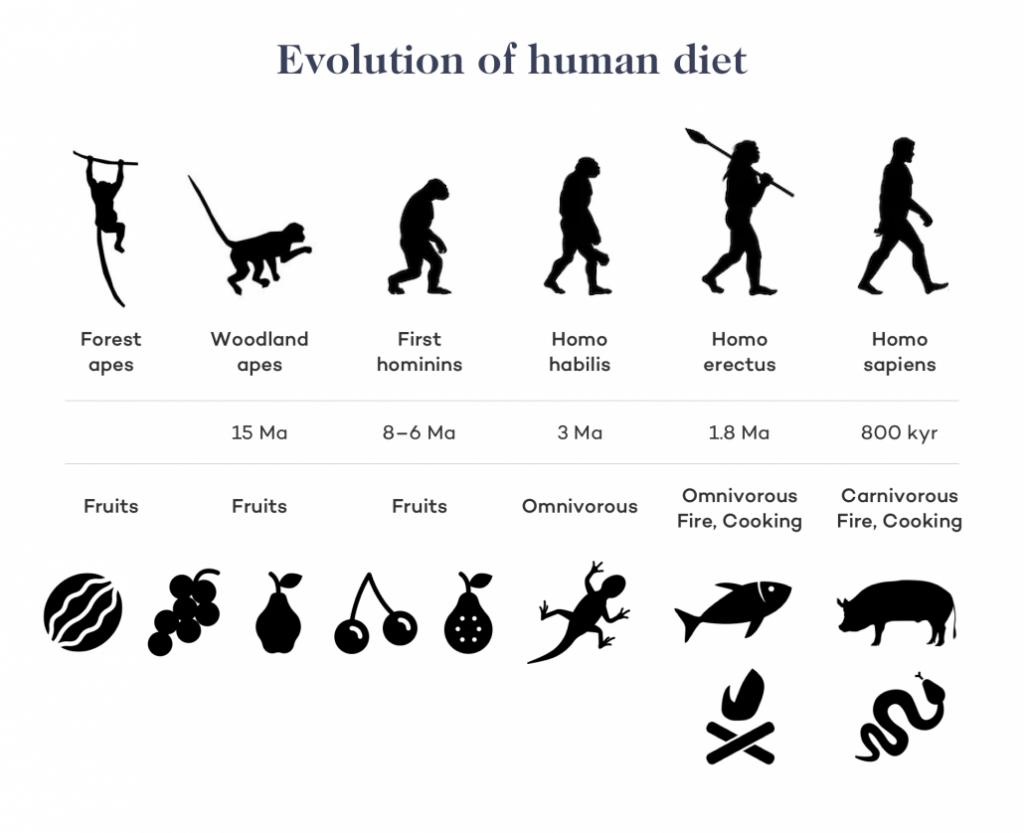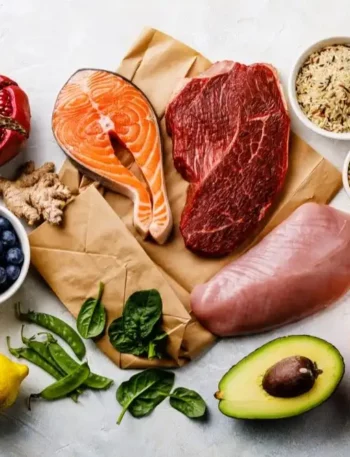
Have you ever wondered how our ancestors chose their food, or how our modern diets came to be? The human diet is not static; it’s a complex evolution shaped by environmental, cultural, and technological changes.
By exploring the different phases of dietary evolution, we gain insight into why we eat the foods we do today and how these changes have impacted our health, society, and planet.
From early hunter-gatherer diets rich in wild plants and meats to the modern-day rise of plant-based foods and health-focused eating, our diets have transformed dramatically.
Let’s journey through time to understand the evolution of human diets and what it means for our present and future food choices.
Early Human Diets – The Hunter-Gatherer Era
In the earliest stages of human history, our diets were shaped by the foods available in the environment. This hunter-gatherer diet, which existed for nearly 90% of human history, was incredibly diverse and nutrient-rich, focusing on wild animals, fish, insects, and a wide variety of plants.
Archaeological evidence shows that early humans ate a mix of meat and plant-based foods, including berries, nuts, roots, and leaves, all of which provided vital nutrients.
According to studies published in the American Journal of Medicine, hunter-gatherers maintained a higher level of physical activity and consumed a diet that was less energy-dense than today’s average diet. This lifestyle likely contributed to lower incidences of diseases like obesity and diabetes, which are more common in modern societies.
Hunter-gatherers were also seasonal eaters, consuming foods based on what was available at different times of the year, a habit that inherently kept their diets varied and balanced.
“The diversity in early human diets likely provided a broader array of nutrients, supporting a healthy metabolism and resilience against chronic diseases.” — Dr. Loren Cordain, Paleo diet researcher
The Agricultural Revolution – From Wild Foods to Crops
Approximately 10,000 years ago, the Agricultural Revolution marked a significant shift as humans transitioned from foraging to farming. This era introduced staple crops like wheat, rice, barley, and maize, which allowed societies to produce food more efficiently and support larger populations.
However, the reliance on staple crops also led to a diet that was lower in variety compared to the hunter-gatherer diet.
The agricultural diet had both positive and negative impacts on human health. While it provided a stable food supply, the shift toward grain-based diets reduced the diversity of nutrients, leading to certain deficiencies and health challenges.
Skeletal remains from this period show evidence of health issues such as reduced stature and signs of malnutrition, indicating that the early farming diet was less balanced than the diverse hunter-gatherer diet.
The Agricultural Revolution allowed human societies to grow but also led to a diet that was more monotonous, impacting nutritional health over generations.
Industrialization and the Rise of Processed Foods
The Industrial Revolution in the 18th and 19th centuries brought rapid advancements in food production and technology. During this period, food processing, refrigeration, and canning became popular, allowing foods to be produced, preserved, and distributed on a larger scale.
Unfortunately, this shift also led to the rise of processed foods, many of which contained added sugars, unhealthy fats, and preservatives.
Processed foods provided convenience and affordability, but the increased consumption of refined and calorie-dense foods had negative health consequences. For instance, the excessive intake of refined sugars and trans fats has been linked to the rise in obesity, heart disease, and diabetes.
Research suggests that diets high in processed foods can disrupt metabolism, contribute to chronic diseases, and lead to weight gain.
Example: The invention of the Twinkie in the 1930s is a quintessential example of a processed food that became emblematic of industrialized diets, despite its lack of nutritional value.
The Globalization of Diets
Globalization has made foods from around the world more accessible, allowing people to enjoy diverse cuisines and flavors. While this trend has promoted cultural exchange and dietary diversity, it has also contributed to the spread of Western-style diets rich in fast food and processed ingredients.
As a result, traditional diets in many parts of the world are being replaced by high-calorie, low-nutrient foods, a shift associated with the “nutrition transition.”
One consequence of the globalized diet is a rise in non-communicable diseases, such as diabetes and cardiovascular issues, in regions where traditional diets were once predominantly plant-based and nutrient-dense.
For example, many Asian countries have seen increasing health challenges as traditional rice and vegetable-based diets are replaced by Western fast foods.
Globalization has broadened food access but also led to health challenges as traditional diets are replaced by processed, energy-dense foods.
Modern Diets and the Rise of Health-Conscious Eating
Today, a growing number of people are becoming health-conscious and are returning to nutrient-dense, whole foods. Modern dietary trends include veganism, the paleo diet, and the ketogenic diet, all of which prioritize natural, minimally processed foods.
This movement is driven in part by research highlighting the benefits of plant-based diets for both personal health and the environment.
Scientific studies indicate that diets rich in whole foods can reduce the risk of chronic diseases. For instance, plant-based diets have been linked to lower rates of heart disease and improved metabolic health, while the paleo and keto diets emphasize reducing processed carbohydrates and sugars.
Tip: Opt for whole foods and avoid overly processed items to align with health-conscious dietary trends.
The Future of Human Diets
Looking ahead, future diets may be shaped by advancements in food technology and a stronger emphasis on sustainability. Innovations like lab-grown meat, plant-based proteins, and insect-based foods offer alternatives that can reduce environmental impact while meeting the protein demands of a growing population.
In addition, the movement towards local and seasonal eating, regenerative farming, and minimal-waste food practices are all part of a broader trend toward sustainable diets.
Researchers believe that these future dietary shifts will prioritize not only health but also environmental stewardship, reducing reliance on resource-intensive livestock farming and promoting agricultural diversity.
“Sustainable diets that consider both planetary health and human well-being are likely to become the norm as we adapt to climate challenges.” — Dr. Walter Willett, Professor of Nutrition at Harvard
The evolution of human diets reflects our changing relationship with food, shaped by social, technological, and environmental factors. From nutrient-dense hunter-gatherer foods to the modern emphasis on sustainability, each stage has left its mark on our health and society.
Key Takeaways:
- Hunter-Gatherer Diets: Diverse and nutrient-rich, supporting health and longevity.
- Agricultural Revolution: Brought stability but introduced new health challenges.
- Industrialization: Led to convenient yet nutrient-poor processed foods.
- Globalization: Broadened food access but spread Western dietary habits and health issues.
- Modern and Future Diets: Emphasize health, sustainability, and technological innovations.
Understanding our dietary past can guide us towards healthier choices in the present and future. By embracing nutrient-dense, environmentally friendly foods, we can make mindful eating a part of our journey forward.









